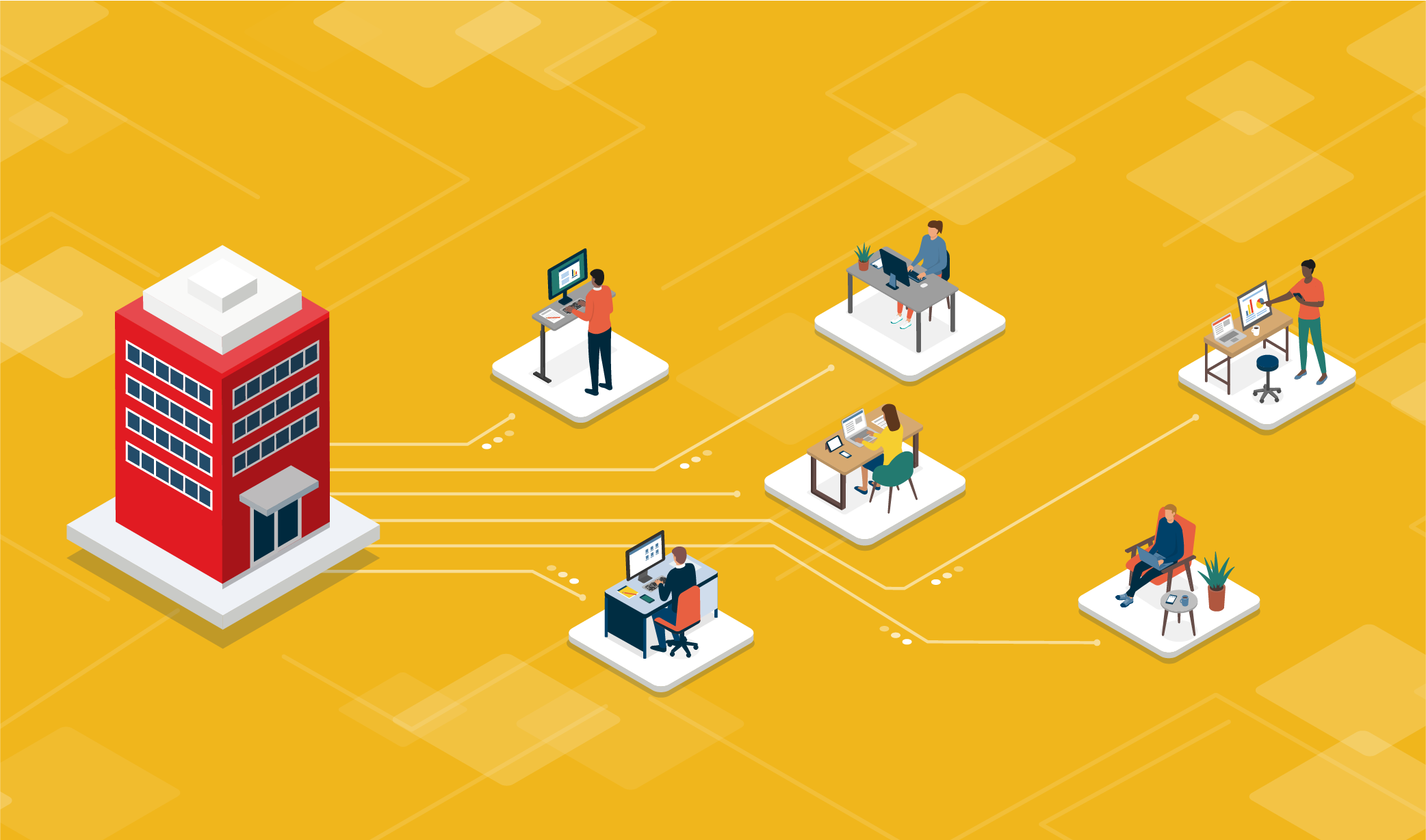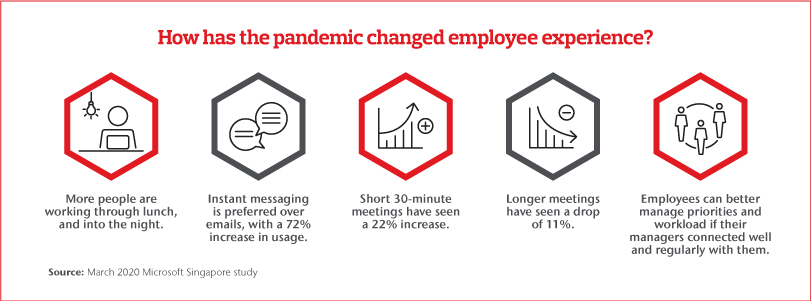
4 Leaders Share: How to Stay Agile During Volatile Times
OVERVIEW
Macro-level changes such as COVID-19 have had micro-level effects on businesses worldwide, including their workforces. These changes have prompted businesses to take stock of and rethink the way they work as risks evolve.
Data-driven discussions, organizational agility, innovative thinking and strategic international programs have been key to helping businesses navigate the turbulence.
“The COVID-19 pandemic has fundamentally shifted how we work,” says Tim Dwyer, Chief Executive Officer, Affinity Solutions Asia and Health Solutions Asia Pacific, Aon. “Businesses have moved from caution, lock down and cashflow issues to cost control, agility and resilience, in hopes of preparing for growth in a post pandemic world.”
Four leaders share how they transformed and optimized their business performance and workforces in the middle of a pandemic.
IN-DEPTH
The new world of work will involve significant workforce change. For example, many businesses are grappling with the challenges of rapidly equipping their employees to work remotely. Leaders across industries are faced with questions such as: “How can I stay competitive and optimize productivity in the new normal?” and “What are some innovative workforce models I can adopt?”
In an increasingly complex and volatile post-pandemic business environment, informed decision making based on knowledge but inspired by genuine insight, has never been more important. At Aon Insights Series 2020: Asia, chiefs from Pan Pacific Hotels Group, Microsoft Singapore, AstraZeneca and Trafigura share their stories of resilience, learning and innovation that have optimized productivity – trends shaping the future of work.
Innovation in crisis
Winston Churchill once said, “Never let a good crisis go to waste.” The pandemic has given Pan Pacific Hotels Group the opportunity to closely re-examine processes as a team and consolidate resources.
“For instance, the organization has centralized its reservations team so that all requests go through a single team, instead of being routed through call centers in countries such as Singapore and Manila,” said Choe Peng Sum, CEO, Pan Pacific Hotels Group. “The centralized reservations team was able to book rooms and also take restaurant reservations.”
The pandemic has also provided the push to the health sector to modernize.
“One of the biggest digitally enabled advancements in the pandemic has been the rise of telemedicine,” observed Leon Wang, Executive Vice President, International and China President of AstraZeneca. “In theory it has existed for years, but the pandemic has pushed the health sector’s hand to upskill and digitize enough to practice it.”
“Patients have moved to online consulting with their doctors, as companies such as ours have helped doctors to better connect with patients virtually,” he added.
Businesses such as AstraZeneca have also had to re-evaluate and rapidly transform business models from serving other businesses to serving consumers. AstraZeneca achieved this by adopting digital solutions and connecting doctors to patients.
“All teams across functions had to mobilize to make this happen. A massive shift in people’s mindset was also imperative in the success of this transformation,” Wang explained. AstraZeneca held digital workshops every day to share best practices and experiences to successfully move to a consumer-focused model within a very short time.
Wang added that there were two sides to the idea that a crisis is the best time to bring about workforce changes. During the transformation process, a large part of the workforce realized that their existing skills were not enough to cope with the new normal, as the entire process had moved online, including offline consumer segments.
In any workforce, Wang continued, there are some who are resistant to change and upskilling. For them, the company implemented as much training as possible. Without the broadening and improving the skills of the workforce, it would be impossible for the company to help its clients and consumers.
Only when the employees had upskilled, for example in Allergen, a business line of AstraZeneca, could they guide their customer on how to go digital to survive financially. This kind of upskilling and knowledge transfer is vital not just to deal with the pandemic period but for the future of work.
Wang noted that there were inevitably some barriers to change. While new habits were formed due to the COVID-19 pandemic, afterwards, some old habits returned. “It is up to business leaders to encourage sustained change,” Wang explained.
For example, the workforce, doctors and consumers have become more digital. People’s skillsets have evolved to include tools and platforms to facilitate telemedicine. To establish these tools as the new normal, the company is in the process of launching supporting digital solutions.
Even though the sector had been severely impacted, Wang pointed out that some business areas saw improvements due to the quarantine. During a challenging period, learning how to maximize the right business areas and downsizing in areas where needed is crucial.
Wang stressed that the lesson is to not be too pessimistic during a crisis or become overconfident and too optimistic about the passing of the crisis. “The right balance can be achieved by constant communication and managing stakeholder expectation,” said Wang.
Technology to build trust
The rapid adoption of technology has not been unique to the hospitality or health sectors.
In fact, many businesses have made technology adoption a top priority to enable remote working and business continuity, said Kevin Wo, Managing Director, Microsoft Singapore. In some cases, two years of digital transformation happened within two months.
For instance, Microsoft Teams, a communication and collaboration platform, has seen a more than 300 percent increase in usage today compared to March 2020. As many as 44 million people use the service per day today, equating 2.7 billion meeting minutes.
Post-pandemic, leaders said we should expect to see some staff working on site, some working from home and others working at a “third place” – a café, or other such location. Choe advised companies to ensure a culture of trust, so that productivity remains optimal, wherever an employee chooses to work.
Wo concurred: “While the new norm will be a blend of remote and physical office space, a corporate culture that empowers employees to do their work anywhere and still collaborate to serve customers will be crucial.”
Care and communication are critical to engage with employees in times of crisis and must be amplified via digital means when everyone shifts to remote working, Wo said. Yet, even with audio and video, the workforce may still lose personal connection. Wo makes sure to have regular check-ins with teams and clients and is looking to maintain these regular connections with all stakeholders.

Leadership of the future
The pandemic has allowed Microsoft Singapore to bring the best of its leadership culture to life. The company delivers success through modelling, coaching and care. Leaders engage in modelling wellbeing best practices so that staff feel less stressed while working remotely. Also, they coach their teams on how to prioritize tasks to maintain an effective work-life balance. Leaders also offer an element of care and show empathy to staff working in different living environments.
“In times of crisis, you don’t run a business, you serve a community,” Wo said.
Such authenticity and sincerity will define the leadership of the future. “When the leadership has the buy-in of the workforce before a crisis and an environment of trust within a company, the effect of any crisis can be overcome,” said Tan Chin Hwee, Chief Executive Officer, Asia Pacific, Trafigura.
Tan also shared how crucial decision making is best allocated to people closer to a crisis. “A bottom-up approach and some amount of regional autonomy was extremely important in making the right decisions during the pandemic,” Tan explained. “From a top-down basis, the best form of assistance was by taking care of employee health, both mental and physical.”
Though Trafigura has navigated not only the pandemic but also a trade war and a COVID-19-related oil crisis, Tan insisted that all aspects of a crisis can be overcome by collectively controlling risk.
End-to-end digitization will be the key to moving forward, said Tan. The key parameter of success will be to preserve and create jobs to move the business, the industry and the economy forward. “A little bit of heart and a lot of hard work will help businesses ride out any storm,” said Tan.
